What’s your default setting? When I can find the best in myself and others, great things happen 🙂
What’s your default setting?
Two Simple Words that Kill Team Creativity
In our creativity workshops, we ask people to participate in a simple exercise. They are to work in partners through 3 scenarios:
- Person A invites Person B to do a favorite activity and Person B keeps responding with No, I can’t.
- Person B invites Person A to do a favorite activity and Person A keeps responding with ‘yeah-but” that will never work, we tried that already, etc etc
- Person A invites Person B to do a favorite activity and Person B keeps responding with”yeah and we could”
We then ask people in which scenario did they feel the most energy and creativity. Not surprisingly, it’s scenario 3. The really interesting thing, however, is that people find the yeah-but response more demoralizing than the straight no. There’s something about no being definitive but objective, whereas yeah-but feels more like a subjective put down of an idea.
Sometimes people really resist the idea of dropping yeah-but from their repertoire. They argue that we’re asking them to give up their logic or expert knowledge. I think yeah-but sometimes gives leaders the allusion that they are just looking after the best interests of the team and trying to save people from disappointment or hurt. But I think that masks the real issue of yeah-butting. I know mine kicks in when I am attached to my way of doing things or feeling a bit insecure or tired and just not up to trying something different or risky.
So the next time you find yourself yeah-butting, take a minute to reflect on your true motives and the impact you’re having on your team’s ability to problem solve and come up with creative ideas.
Written by Tammy and based on the 5 of diamonds from our Teamwork Explorer.
10 Reasons We Use Email to Manage Conflict and How to Stop it!
I take a risk with this blog’s video. I am new to using advanced features in powerpoint and new to converting powerpoint to a video format. I hope you enjoy it (more importantly I hope my point is clear!) and while I am open to feedback, please be gentle 🙂
More time and energy is wasted on escalating “email wars.” I have been both instigator and hapless recipient. Why do we do this? A few reasons come to mind:
- We misread the intent behind the email because so much of the visual and emotional context is missing.
- We are stressed and have lost perspective and don’t think we have time to deal with an issue.
- We work on a virtual team and so face to face immediate contact isn’t possible (there’s a bit of an excuse here but with technologies like Skype not so much.)
- We don’t have a whole lot of emotional intelligence, in particular self and relationship management.
- We’re better writers than talkers and there’s a fair bit of satisfaction to be gained from a brilliantly (albeit destructively) worded email.
- We’re procrastinators and it’s more interesting to engage in an email war than get on with a really difficult project.
- We read meaning into an email (whether real or imagined is not important) about our overall competence or identity and feel a need to come to our own defense.
- We’ve been avoiding a difficult conversation with someone for some time and seize the opportunity to be righteous.
- We poked at wasp’s nests as kids and the pattern is still alive and well and thriving.
- We’re cowards, willing to put something in an email, but not address an issue face to face.
Outside of #9, I think I’ve been guilty of all of these although in the last few years I have learned some skills. Here’s what I try to do:
BREATHE … Breathe, Resist (React), Explore, Alternatives, Time, Honest, Expression
Put together … Breathe, resist the urge to react, explore alternative interpretations, take time before responding, take an honest look at your motivations and come up with an authentic and positive expression … whether that is heading down the hallway and having a face to face chat or asking your colleague halfway across the world for a skype call the next convenient time.
Oh, and BTW, BREATHE works if you are instigator or hapless recipient 🙂
This blog is based on the 3 of Diamonds, Don’t Use Email to Manage Conflict, from our Teamwork Explorer. Written by Tammy
An Acronym That Will Make your Day and Build your Team
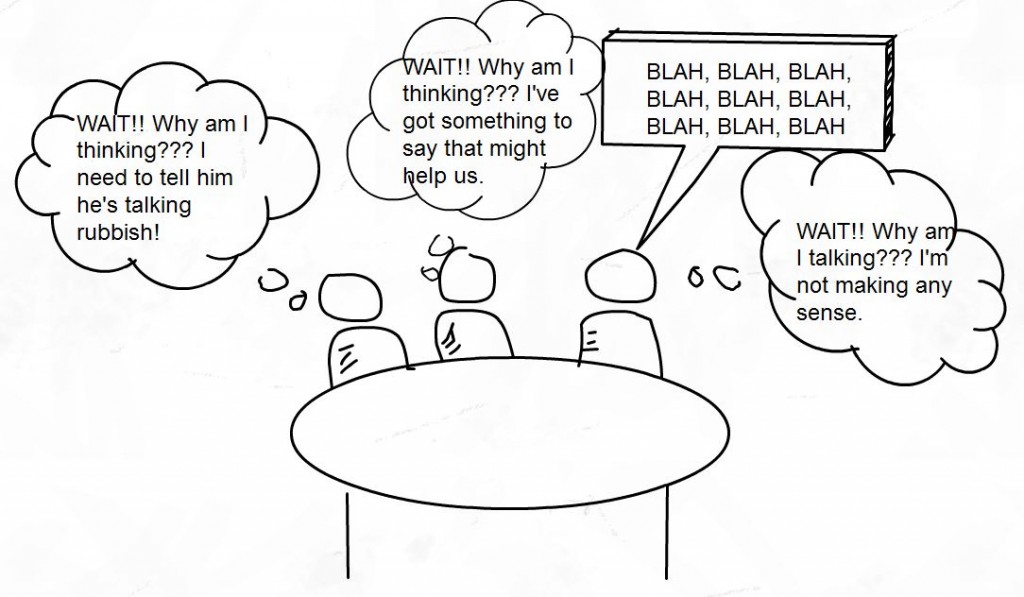
The cartoon says it all … how would doing the opposite of your usual communication style make someone’s day and build your team?
Oh, and in case you didn’t catch the acronym, it’s WAIT (why am I talking/thinking?)
This blog is based on the 9 of Diamonds, WAIT, taken from our Teamwork Explorer. Written by Tammy.
If Computer Problems Were Real
My computer crashed yesterday and I am still waiting for the computer doctor to let me know if it will live. Right now I am making do on an old laptop, and every time I go to do something, I realize I actually do not have anything I need to do what I need to do. I’ve become even more unorganized than I usually am and have spent a fair bit of time staring off into space (well, this is not entirely true … I’ve actually spent more time swearing and yes, crying, and yes, sending desperate emails and text messages to my computer techie whiz of a husband …)
Our home has not been a particularly happy one for the last 24 hours. Patience and optimism are not my natural tendencies … just ask my ever patient, optimistic husband.
So, what’s a stressed out woman to do? First off … breathe … and then perhaps take the advice that she often dishes out to her coaching clients. Rule #6 … the one that says, “Stop Taking Yourself so Damn Seriously!!!!” No one is sick, no one has died, you do have a fairly recent backup of your computer, etc, etc … in other words, ask myself, how important will this be:
- 6 minutes from now?
- 6 hours from now?
- 6 days from now?
- 6 weeks from now?
- 6 months from now?
- 6 years from now?
I only got to the first two and so need to get over myself and put things into perspective. Find something to appreciate in my life, go for a walk, phone a friend I haven’t talked to in a while, organize my desk, find something to laugh about like “If Computer Problems Were Real” …
This blog is based on the 6 of Hearts, Rule #6 by Ben Zander, taken from our Teamwork Explorer. Written by Tammy.
Silo Busting 101
The Blind Men and the Elephant is an old parable (popularized by John G Saxe’s poem as read in the YouTube video above), and like all great wisdom and insight, stands the test of time. It’s perhaps even more relevant in today’s overly complex world than it was when it was originally told. The basic premise is that 6 blind men each have a hold of a different part of the elephant. One thinks he is holding a snake (the trunk of an elephant) another a tree trunk (leg), etc. Though each of them might be partly right, they are all wrong about what they are holding.
For me, it’s one of those powerful analogies that I call on whenever I work with teams and organizations who may have become “entrenched” or “siloed” in particular viewpoints and, therefore, aren’t really working well together. It’s also something I have to remind myself to call upon whenever I have become entrenched as well!
It’s a simple concept. Why is it so difficult to apply? A few reasons occur to me:
- We are problem solving beings who want quick solutions.
- Our identities are wrapped up in being right.
- We are too busy to take the time to fully explore a particular challenge.
- If we consider other perspectives, we fear we will need to compromise or give up something.
- We are future oriented and have a difficult time paying attention to present realities.
- GU – goo – what’s that you ask? It’s Growing Up goo … and it refers to the types of defense mechanisms we develop in childhood based on messages we get from our families, schools, etc
- Others?
Whatever the case, it’s true that this basic inability to “consider the whole elephant” is at the heart of most miscommunication and a silo mentality. Weisbord and Janoff in Don’t Just Do Something, Stand There! (one of THE best books on leading meetings I’ve ever seen) suggest that exploring the whole elephant (or “getting the whole system in the room”) is necessary in order that people experience that they:
- live on the same planet, subject to the laws of nature
- share the same psychological and physical needs
Only when they have experienced this, can people move on to resolve differences and tackle problems.
How can you do this in your organization? Here are a few things to consider based on some of Weisbord and Janoff’s ideas:
- Be willing to take the time to understand the issue/challenge BEFORE jumping to a solution or an action plan. This bit of patience is perhaps the hardest first step of all.
- Get the whole system in the room. If you want to silo bust, you need to bring people from each silo into the room together!
- Do regular roundtables or check-ins on topics as part of your meetings. Encourage all perspectives are heard by surfacing different perspectives yourself.
- Draw a mindmap of challenges with all stakeholders in the room before you try to resolve an issue.
- If your team is having trouble speaking freely, have each person brainstorm their challenges or perspectives, one idea per post it note. Post these notes on the wall, talk about them and then theme and name them. Then, discuss specific solutions.
- Engage in teambuilding activities that help you see each other as people. When teams (and people across teams) start to drift apart, they often start to see each other as “positions” and the “enemy” and not people. Do things together that force you to have conversations that are not about work (like cooking together, bowling, golfing, etc)
Do you have any other strategies for exploring the whole elephant? I would love to hear them!
This blog is based on the 8 of Diamonds, The Blind Men and the Elephant, taken from our Teamwork Explorer. Written by Tammy.
Top 5 Tips for New Teams

Thanks to http://thegoldguys.blogspot.com/
While some teams stay together for years, others need to come together and deliver results quickly. These top 5 tips are taken from our Teamwork cards. Each of the following tips also has a full blog post to support it, should you need more detail.
- Ace of Hearts – Develop a Shared Vision – There is no one right way to develop a shared vision but sometimes approaching it indirectly can be easier for people. Have each member of your team answer the following questions. Once everyone has identified their responses, have a team discussion and see what emerges as a result. This can lead to a vision statement in a more concrete way than just asking people to describe their vision. Think back to a great team experience. Describe that experience. What was it about that experience that was so positive? How did it differ from other team experiences? How can this team create that kind of experience? What would we commit ourselves to? What values would we demonstrate?
- Jack of Spades – Play to your Strengths – Everybody performs better when they play to their strengths. Make sure that individuals’ strengths are taken into account when roles are assigned and tasks allotted. One way to do this would be to have the team discuss what strengths would be needed to accomplish a role or task before it is allotted. Also check out Gallup’s Strengths Finder book for a more formal approach to discovering your strengths.
- Ace of Spades – Accountability – Knowing who is responsible for what is vital to a team’s success. It’s very easy for these accountabilities to be too vague, especially when there are changes in team membership. Who is responsible for what is the most important thing to have documented at the end of any team meeting.
- Ace of Clubs – Deciding how to Make Decisions – One of the most important things a team leader does is decide how best to make any particular decision. There are numerous decision making strategies such as democratic, consensus, and autocratic, but knowing which to use in any particular context is the real key to successful decision making on teams. Leaders should pay particular attention to the number of people involved and the magnitude of the impact of the decision when selecting a decision making strategy.
- Nine of Hearts – Be Present –People have become accustomed to being constantly connected to email no matter where they are. While some people can be effective multi-taskers, sometimes this pre-occupation with mobile devices can be a way to avoid unpleasant conversations and/or distract you from important activities and conversations. Monitor your “presence” and that of your team members, and use technology wisely. What message are you sending with your Blackberry use?
This blog post is inspired by Teamwork Explorer – an iPhone app. Along with this “winning hand” for a new team, the app features 12 other common team challenges and offers solutions for each.
Are Mobile Phones Derailing Difficult Conversations?
The idea that Blackberry usage can actually lower your IQ and curb creativity has been around for a few years now. Linda Stone calls this continuous partial attention and suggests that people engage in it because they don’t want to miss anything. I think the reverse is sometimes true – people will use their Blackberries TO MISS something.
I became aware of this a few years ago while working with an executive team. The team was comprised of executives from two different companies and they were going through a challenging merger. Whenever certain topics would surface, the CEO would grab her notebook and write furiously. The CFO soon followed by becoming completely preoccupied with his Blackberry. After watching this for half a day, I commented on it and asked whether this pattern of behavior meant anything. Turns out it did and the conversation that unfolded led to some great insights for the team and a request that the team “be present” with each other at meetings from then on.
What role do mobile devices play on your team? Do team members engage in any other distractions (like writing in a notebook, thinking about tonight’s dinner, cracking a joke) when uncomfortable or unpleasant conversations come up? What would it mean to “be present” on your team and how might that enhance your team effectiveness and creativity?
This blog is based on the 9 of Hearts, Be Present, taken from our Teamwork Explorer. Written by Tammy.
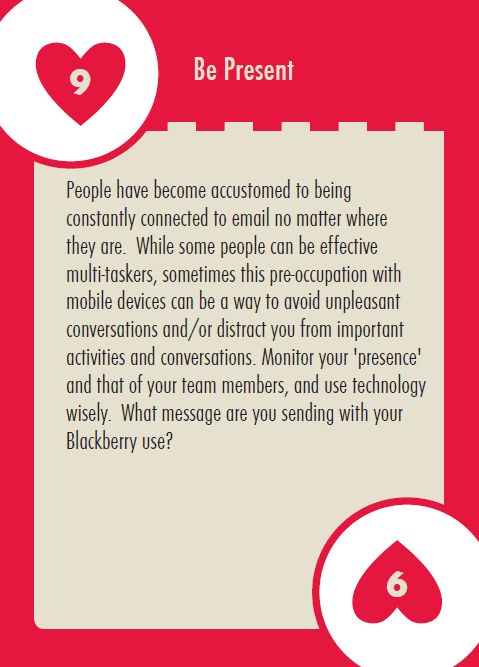
What do Cartoon Thought Bubbles Have to do with Teams?
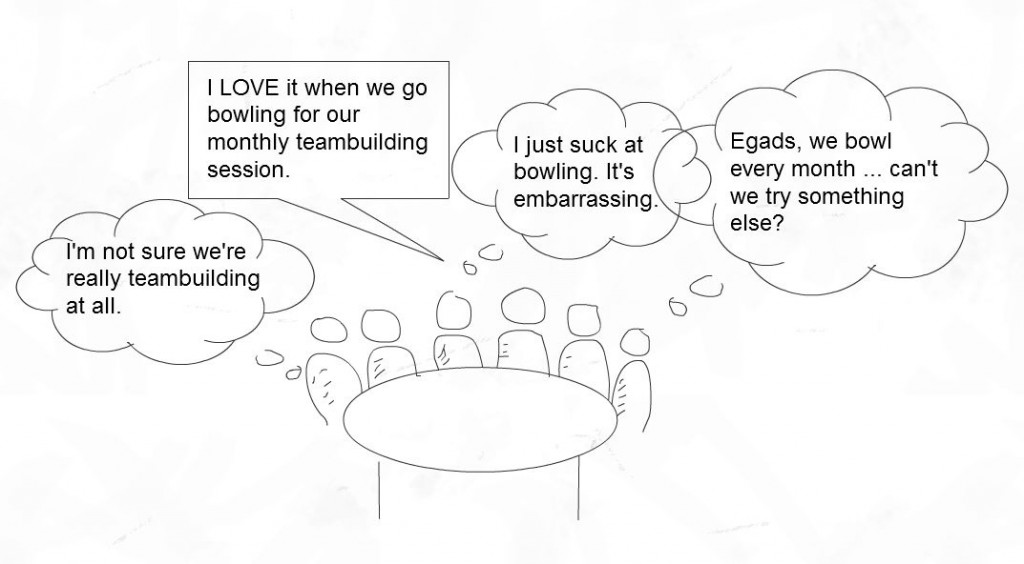
Thought Bubbles in Action on a Team
“I feel like Switzerland and I just want to bash their heads together.” Sarah was exasperated with two members of her team and was telling me how tired she was of listening to their stories and how awkward team meetings were becoming.
“What would happen if you told them that? Perhaps not about bashing their heads together but about how you feel? How might that change things for you and your team?” It had never occurred to Sarah to do this and there was quite a long silence. By the end of our conversation she realized how her silence had been contributing to keeping the unhealthy dynamic between her two colleagues going. She also realized that there was some risk in actually letting them in on her “real” thoughts, but that the potential gains could outweigh the risks.
It’s pretty common for people not to reveal their true thoughts in team situations. Sometimes it relates to being conflict avoidant, sometimes to groupthink, sometimes to an overly “politically correct” culture on the team, and sometimes to fear of being vulnerable all of which are demonstrated in the cartoon above. Whatever the case, if you find yourself going over situations long after they’re over and feeling unsettled, it may be time for you to examine the role that your “thought bubbles” are playing. Here’s one of my own examples and how I dealt with it:
I’ve worked with many co-facilitators over the years to deliver various training programs and inevitably the program has some sort of evaluation form. Most times the form lists each person’s name and then asks for an individual rating of each person. This has always bothered me in that if we are working as a team and co-delivering a program, I think we should be rated as a team, not individuals. Inevitably, if rated individually, one member’s ratings will always be the lowest and one member’s ratings will always be the highest. It sets up a competitive and uncomfortable dynamic. So, I have been dealing with this for years and finally (sometimes I am a slow learner too!) I followed the 4 steps I recommend to others:
- What role have your thoughts and feelings in your thought bubble played in the situation unfolding as it has? Whenever the topic of evaluation comes up on a team, I get uncomfortable and a bit cranky and end up not participating meaningfully and saying things like “I hate evaluations … we get feedback along the way so what’s the point?” I end up having a conversation that doesn’t really capture my true thoughts and probably frustates my team members.
- What are the risks and opportunities of sharing your thought bubble? The risk is that someone might disagree with my suggestion to do a team rating and think that I am insecure about my own abilities, that the real reason I want a team rating is so I don’t end up at the bottom. The opportunity is that at least I can be more honest and authentic about why the topic of evaluation bothers me and perhaps even have my team agree with a team rating.
- What would need to change in order for you to share your thought bubble? I just need to be more confident about my own opinion, that I have given the matter some thought and that it’s not a suggestion I make lightly. The other thing that needs to change is to bring up the topic when we have time to more fully discuss it instead of at the last minute during a program.
- What’s a small step you can take to bring more of your thought bubble to team conversations? I can suggest that the next time we do a program that we add the evaluation form to our initial planning sessions. I can also then preface my comments with “I’ve been thinking about this a lot and was wondering if we could …?
I’m pleased to report that I did indeed bring up this topic and that the outcome was positive. It allowed me to be more authentic and it allowed my team members to get to understand my perspective a bit better.
While this was a positive outcome, sometimes your reflections might lead you to conclude that it is simply too risky to share your thought bubble. If this is the case, then you need to find a way to let go of the issue and not let it continue to permeate your thoughts and, therefore, your presence and interaction on the team. How to do THAT is another blog post …
This blog is based on the 10 of Diamonds, Sharing Thought Bubbles, taken from our Teamwork Explorer.
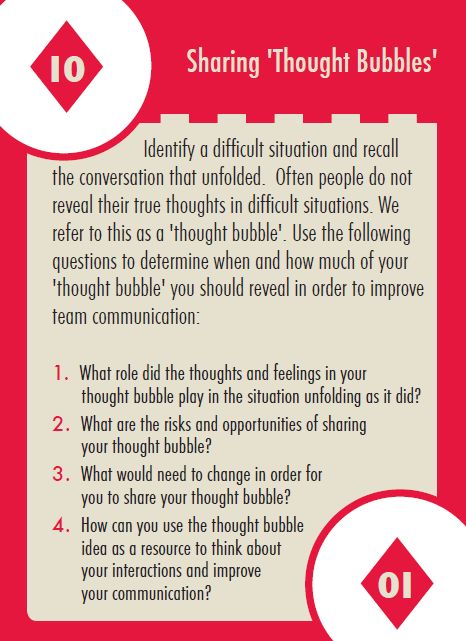
Sharing Thought Bubbles
How your Team can Save Time and its Sanity
I was becoming frustrated with our team. Three days and dozens of emails later we were still no closer to solving the problem. The problem you ask? Finding a date for our next meeting! Egads, for a group of reasonably competent, smart people we certainly were limiting our effectiveness by using the wrong technology. In my own experience on teams and from coaching other teams, the two time wasters I see are using email to make decisions (including scheduling meetings!) AND, get ready … emailing Word documents and using track changes to collaboratively work on something.
We’ve learned a lot over the years from virtual team practitioners and writers. Our favorite writers are Duarte and Snyder whose book Mastering Virtual Teams is a must have for anyone who works on a team, whether virtually dispersed or not. It is full of hints, tips and strategies. A few years ago, we adapted some of their ideas to produce a collaborative task identification tool. We suggest that teams talk about the types of tasks they face and the types of technology they can use. The chart below does not deliberately identify specific technology as technology changes too rapidly for that, but we hope the chart is a useful starting place for teams. After the chart, I’ve listed 6 ways you can save time on your team by using the right technology for the right task.
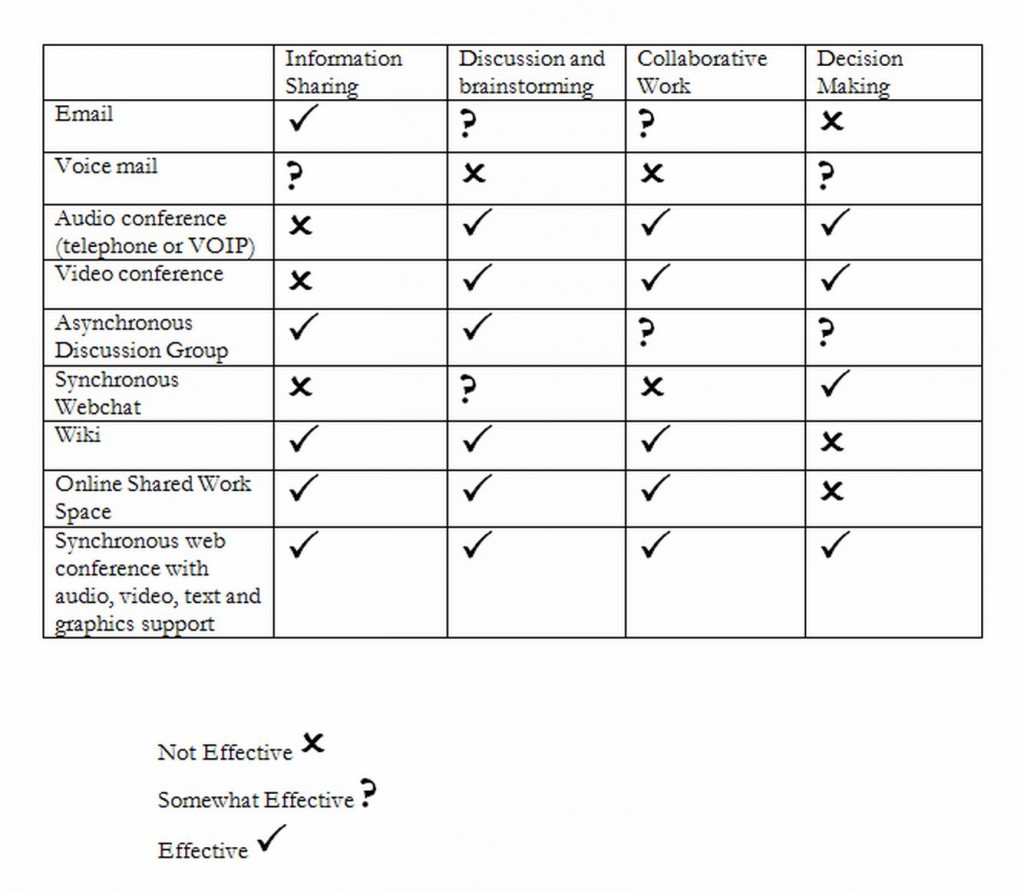
Collaborative Task Tool, Calliope Learning adapted from Duarte and Snyder
Here are 6 of my favorite tools and they all offer free versions:
- Meeting Wizard – Stop the email craziness and use this tool to schedule your meetings!
- Rypple – Easily get feedback and hand out kudos using this very neat online survey type tool.
- Skype – I probably don’t need to mention this one but if you are a virtual team, skype is a must have for real time chats.
- Google Docs – is a simple and easily accessible way to share and co-edit documents.
- Yammer – is a Facebook type application but more geared towards productivity. You can set up your own private yammer group and use it to communicate and collaborate, share documents, etc. It also has smart phone versions so you can use it from your phone or computer.
- Mindmeister – is collaborative mindmapping software for the creative types out there.
I hope this has given your team some ideas! Have you found any cool tools to use? I would love to hear about them!
Today’s blog comes from our Teamwork Explorer, 10 of Spades card. Posted by Tammy.
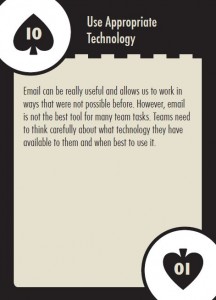
Use Appropriate Technology



